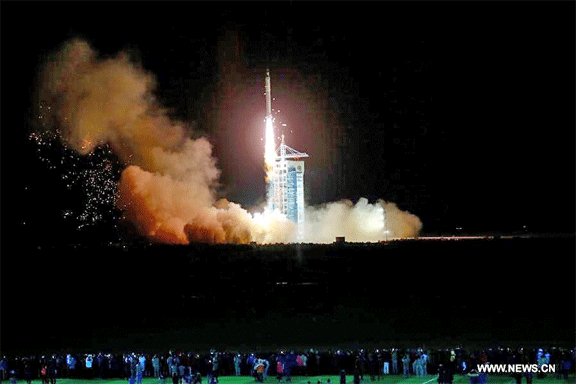
The Chinese launch of the SJ-10 research satellite aboard a Long March 2-D rocket.
Photo courtesy of news.xinhuanet.com.
[Satnews] India's OneWeb infosite is reporting that China just launched a retrievable scientific research satellite in a bid to aid scientists to study micro-gravity and space life science.
SJ-10 was put into orbit by a Long March 2-D rocket from the Jiuquan Satellite Launch Centre in northwestern China's Gobi desert. While in space, the bullet-shaped probe will house 19 experiments involving microgravity fluid physics, microgravity combustion, space material, space radiation effect, microgravity biological effect and space bio-technology, before coming back to Earth with results, according to the state-run Xinhua news agency.
The on-board experiments were selected from a pool of more than 200 applicants. They include one that will study early-stage development of mouse embryos in microgravity to shed light on human reproduction in space. Another will study space radiation effects on genetic stability of fruit flies and rat cells. A "Soret Coefficient in Crude Oil" experiment in partnership between the National Space Science Center under CAS and the European Space Agency (ESA) is also also onboard together with an investigation of coal combustion and pollutant formation under microgravity. The former test is aimed to improve scientists' understanding of oil reservoirs buried kilometers underground, while the latter is expected to help enhance energy efficiency and cut emissions.
"All experiments conducted on SJ-10 are completely new ones that have never been done before either at home or abroad,"d Hu Wenrui, chief scientist of the SJ-10 mission said. "They could lead to key breakthroughs in our academic research. SJ-10 is the second of four scientific satellites under a CAS space program. Unlike the others, SJ-10 is returnable. It is the 25th such retrievable satellite launched by China in the past decades. Overall, eight of the experiments on fluid physics and microgravity combustion will be carried out in the orbital module and the others in the re-entry capsule which is expected to land at Siziwang Banner in Inner Mongolia, the designated landing spot for China's Shenzhou manned space missions and a 2014 test lunar orbiter.

